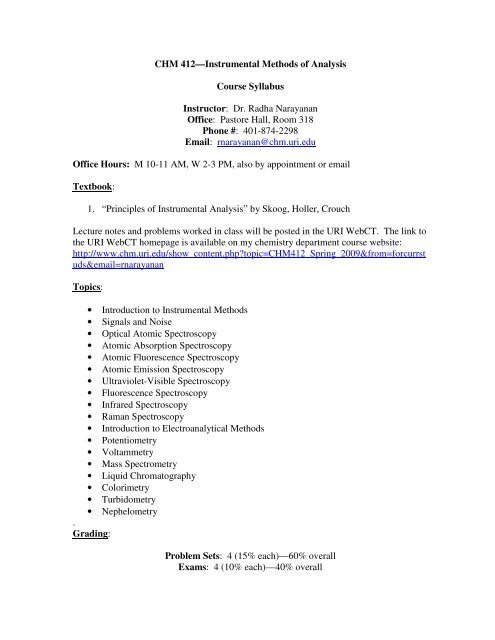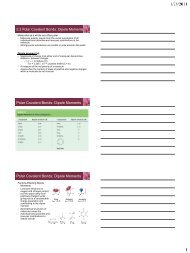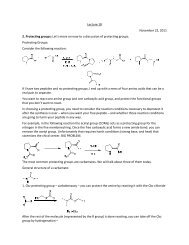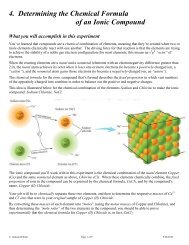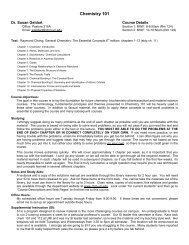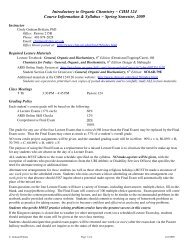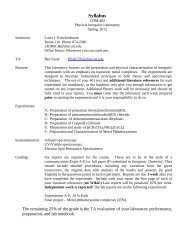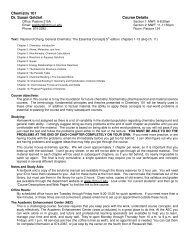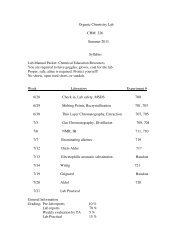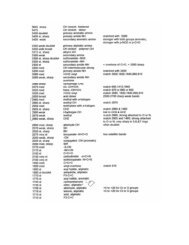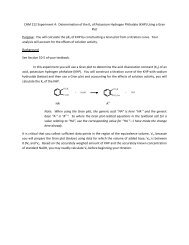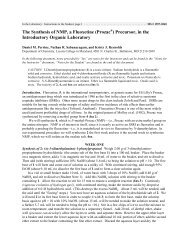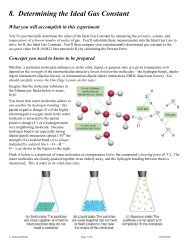CHM 412—Instrumental Methods of Analysis Course Syllabus - URI ...
CHM 412—Instrumental Methods of Analysis Course Syllabus - URI ...
CHM 412—Instrumental Methods of Analysis Course Syllabus - URI ...
- No tags were found...
You also want an ePaper? Increase the reach of your titles
YUMPU automatically turns print PDFs into web optimized ePapers that Google loves.
<strong>CHM</strong> <strong>412—Instrumental</strong> <strong>Methods</strong> <strong>of</strong> <strong>Analysis</strong><strong>Course</strong> <strong>Syllabus</strong>Instructor: Dr. Radha NarayananOffice: Pastore Hall, Room 318Phone #: 401-874-2298Email: rnarayanan@chm.uri.eduOffice Hours: M 10-11 AM, W 2-3 PM, also by appointment or emailTextbook:1. “Principles <strong>of</strong> Instrumental <strong>Analysis</strong>” by Skoog, Holler, CrouchLecture notes and problems worked in class will be posted in the <strong>URI</strong> WebCT. The link tothe <strong>URI</strong> WebCT homepage is available on my chemistry department course website:http://www.chm.uri.edu/show_content.php?topic=<strong>CHM</strong>412_Spring_2009&from=forcurrstuds&email=rnarayananTopics:• Introduction to Instrumental <strong>Methods</strong>• Signals and Noise• Optical Atomic Spectroscopy• Atomic Absorption Spectroscopy• Atomic Fluorescence Spectroscopy• Atomic Emission Spectroscopy• Ultraviolet-Visible Spectroscopy• Fluorescence Spectroscopy• Infrared Spectroscopy• Raman Spectroscopy• Introduction to Electroanalytical <strong>Methods</strong>• Potentiometry• Voltammetry• Mass Spectrometry• Liquid Chromatography• Colorimetry• Turbidometry• Nephelometry.Grading:Problem Sets: 4 (15% each)—60% overallExams: 4 (10% each)—40% overall
Lecture Schedule:1/21/09—Introduction to Instrumental <strong>Methods</strong> (Ch. 1)1/23/09—Introduction to Instrumental <strong>Methods</strong> (Ch. 1), Problem Set #1 Assigned1/26/09—Signals and Noise (Ch. 5)1/28/09—Introduction to Spectroscopic <strong>Methods</strong> (Ch. 6)1/30/09—Introduction to Spectroscopic <strong>Methods</strong> (Ch. 6)2/2/09—Introduction to Optical Atomic Spectroscopy (Ch. 8)2/4/09—Introduction to Optical Atomic Spectroscopy (Ch. 8)2/6/09—Atomic Absorption and Atomic Fluorescence Spectroscopy (Ch. 9)2/9/09—Atomic Absorption and Atomic Fluorescence Spectroscopy (Ch. 9)2/11/09—Atomic Emission Spectroscopy (Ch. 10)2/13/09—Atomic Emission Spectroscopy (Ch. 10), Problem Set #1 Due2/18/09—Brief Review2/20/09—Exam #1—topics in Ch. 1, 5, 6, 8, 9, 102/23/09—Introduction to Ultraviolet-Visible Molecular Absorption Spectrometry (Ch. 13),Problem Set #2 Assigned2/25/09—Introduction to Ultraviolet-Visible Molecular Absorption Spectrometry (Ch. 13)2/27/09—Applications <strong>of</strong> Ultraviolet-Visible Molecular Absorption Spectrometry (Ch. 14)3/2/09—Molecular Luminescence Spectroscopy (Ch. 15)3/4/09—Molecular Luminescence Spectroscopy (Ch. 15)3/6/09—Introduction to Infrared Spectroscopy (Ch. 16)3/9/09—Introduction to Infrared Spectroscopy (Ch. 16)3/11/09—Applications <strong>of</strong> Infrared Spectroscopy (Ch. 17)3/13/09— Raman Spectroscopy (Ch. 18)3/23/09—Raman Spectroscopy (Ch. 18), Problem Set #2 Due3/25/09—Brief Review3/27/09—Exam #2 (Ch. 13, 14, 15, 16, 17, 18)3/30/09— Molecular Mass Spectrometry (Ch. 20), Problem Set #3 Assigned4/1/09— Molecular Mass Spectrometry (Ch. 20)4/3/09— Liquid Chromatography (Ch. 28)4/6/09— Liquid Chromatography (Ch. 28)4/8/09— Colorimetry, Turbidometry, Nephelometry (handout), Problem Set #3 Due4/10/09—Brief Review4/13/09— Exam #3 (Ch. 20, 28, handout)4/15/09— Introduction to Electroanalytical <strong>Methods</strong> (Ch. 22), Problem Set #4 Assigned4/17/09— Introduction to Electroanalytical <strong>Methods</strong> (Ch. 22)4/20/09—Potentiometry (Ch. 23)4/22/09—Potentiometry (Ch. 23)4/24/09—Voltammetry (Ch. 25)4/27/09—Voltammetry (Ch. 25), Problem Set #4 Due4/29/09—Brief ReviewFinal Exam: Ch. 22, 23, 25
General Policies:The work that you turn in for the problem sets should be based on your own individualeffort. For the exams, only standard scientific calculators will be permitted. Calculatorswith graphing and data storage functions will not be permitted during the exam. For theexams, you may prepare one handwritten 8.5 x 11 in. sheet with notes, formulas, etc. onthe front side only to use during the exam.


